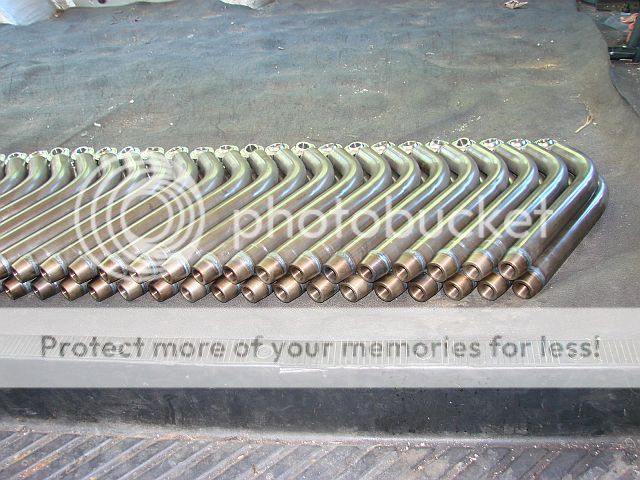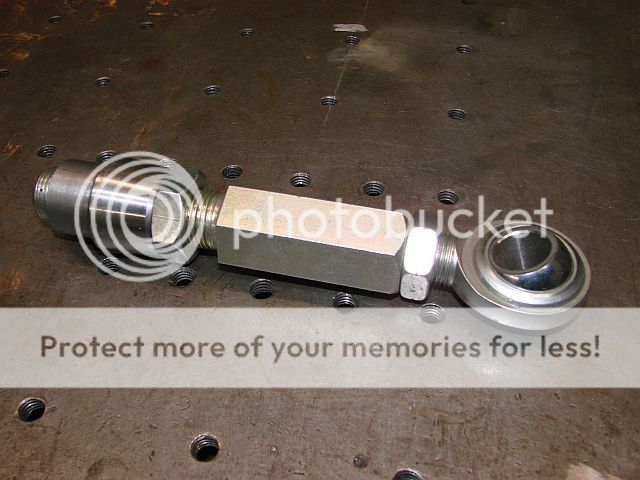Jamestat2
New Member
Some points to ponder:
• Pipe is generally more rigid than tube, and is usually produced in heavier wall thicknesses.
• Pipe is specified by a nominal dimension which bears little or no resemblance to the actual dimensions of the pipe. 1" Schedule 40 pipe, for instance, has an actual OD of 1.32", a wall of 0.133", and an inner diameter of 1.049". Tube dimensions are actual dimensions.
• Pipe fittings are sized to meet pipe sizes, but not tube sizes. A 1" schedule 40 nipple will fit correctly on a 1" schedule 40 pipe, but not on a 1" OD tube.
Tube refers to round, square, rectangular or any shape of hollow material of uniform thickness which is defined by the outside diameter and wall thickness dimensions. It is the grade of the metals and how tube is produced and processed that is important.
• Structural Tube is generally produced using the ERW (Electric Resistance Welded) process. Identified under the Circular Hollow Section (CHS) or Hollow Structural Sections (HSS) class. Some steel mills specifically develop structural tube for roll over protective structures.
• Mechanical Tubing is usually produced as seamless, as-welded or DOM (Drawn Over Mandrel) tube.
Types of Tube and Pipe
Structural Tube - high strength welded steel tubing
Mechanical Tube - seamless, as-welded and drawn over mandrel
Stainless Tubing and Pipe - several seamless and welding processes requiring resistance to corrosive materials
Standard Pipe - several seamless or electric weld process, carries liquid or gas
What the acronyms mean:
Electric Resistance Welded (ERW)
Cold Drawn Welded (CDW)
Drawn Over Mandrel (DOM)
Cold Drawn Seamless (CDS)
Cold Rolled Electric Welded (CREW)
Hot Rolled Electric Welded (HREW)
Thier descriptions:
Electric Resistance Welded (ERW)
Cold formed, electric resistance welded tubing can be produced in round, square or rectangle shapes. ERW tube is produced by processing a flat rolled steel into strips which are cold-formed, welded and seam annealed or normalized (depending on the manufacturer). You can usually identify ERW tube by the blue strip down one side of the tube (which is the welded area). The ERW process can guarantee the weld to be as strong or stronger than the rest of the tube body. The origin from a flat strip results in a more concentric product than Cold Drawn Seamless (CDS). ERW can also be known as CREW (Cold Rolled Electric Welded).
Typical Applications:
Structural columns, beams, supports, heavy equipment frames with 58,000 PSI tensile.
Cold Drawn Welded (CDW)
Produced from a steel strip by cold forming, electric resistance welding (ERW) and cold drawing to finished dimensions, CDW is the most versatile and widely sold mechanical tubing grade. A variety of thermal treatments can be applied to alter the mechanical properties and machinability. CDW is used for a tremendous variety of machine parts where close tolerances and higher mechanical properties are needed.
Typical Applications:
Automotive components, shock absorbers, hydraulic cylinders, sleeves, bushings, axles and shafting.
Drawn Over Mandrel (DOM)
DOM is formed from strip and Electric Resistance Welded (ERW) then cold drawn through a die and over a mandrel resulting in improved inner surfaces and dimensional quality. This process, called cold drawing, may be repeated more than once to reach the planned OD, ID, or wall dimension. Multiple draws can also be used to increase the strength or improve the surface finish of the tubes. During the drawing operation, the tubes may be process annealed to increase the ductility of the material. Lower cost alternative to CDS with equal or superior physical properties.
Typical Applications:
Machined parts, rollers, shafts, sleeves, steering columns, axle tubes, drive shafts, bushings and is most readily adaptable in cylinder applications with a 80,000 PSI tensile.
Cold Drawn Seamless (CDS)
General purpose seamless tubing, which is a solid bar of carbon steel drawn over a mandrel to form the tube section. CDS allows selection of chemistry and rough tube size. Cold drawing produces higher physical properties without heat treating. Offers widest range of sizes and chemistries in mechanical tubing. Better tolerances and reduced machining allowances over Hot Finished Seamless (HFS).
Typical Applications:
Machined parts, bushings, spacers, bearings, rollers, shafts, sleeves and cylinders with a 75,000 PSI tensile.
Cold Rolled Electric Welded (CREW)
Cold rolled steels are steels that are shaped by high pressure rollers at normal temperature in the steel mill. Cold rolling work hardens the material substantially. The steel is then welded by the electric weld process. A cold rolled steel can be either a mild steel or a high carbon steel. Can also be termed as ERW (Electric Resistance Welded). See » ERW
Hot Rolled Electric Welded (HREW)
Hot rolled steel is steel that is rolled to size in the mill while red hot. Hot rolling steel does not work harden it as much as cold rolling. For this reason, hot rolled steel is more easily machined than cold rolled.
What's the difference between Tube and Pipe?
The general term for pipe was that it was primarily used for carrying gas or liquid. It was not intended for structural use because the dimensions used in describing pipe was not dimensionally accurate. Measurement was referred to its inside diameter and wall thickness. The inside diameter was a true dimension, but over the years had become "nominal" (in name only) so that when pipe size was referred to, it was an approximate inside diameter measurement with the thickness described by the term "schedule".
Hope this helps someone as it did me! LOL!
• Pipe is generally more rigid than tube, and is usually produced in heavier wall thicknesses.
• Pipe is specified by a nominal dimension which bears little or no resemblance to the actual dimensions of the pipe. 1" Schedule 40 pipe, for instance, has an actual OD of 1.32", a wall of 0.133", and an inner diameter of 1.049". Tube dimensions are actual dimensions.
• Pipe fittings are sized to meet pipe sizes, but not tube sizes. A 1" schedule 40 nipple will fit correctly on a 1" schedule 40 pipe, but not on a 1" OD tube.
Tube refers to round, square, rectangular or any shape of hollow material of uniform thickness which is defined by the outside diameter and wall thickness dimensions. It is the grade of the metals and how tube is produced and processed that is important.
• Structural Tube is generally produced using the ERW (Electric Resistance Welded) process. Identified under the Circular Hollow Section (CHS) or Hollow Structural Sections (HSS) class. Some steel mills specifically develop structural tube for roll over protective structures.
• Mechanical Tubing is usually produced as seamless, as-welded or DOM (Drawn Over Mandrel) tube.
Types of Tube and Pipe
Structural Tube - high strength welded steel tubing
Mechanical Tube - seamless, as-welded and drawn over mandrel
Stainless Tubing and Pipe - several seamless and welding processes requiring resistance to corrosive materials
Standard Pipe - several seamless or electric weld process, carries liquid or gas
What the acronyms mean:
Electric Resistance Welded (ERW)
Cold Drawn Welded (CDW)
Drawn Over Mandrel (DOM)
Cold Drawn Seamless (CDS)
Cold Rolled Electric Welded (CREW)
Hot Rolled Electric Welded (HREW)
Thier descriptions:
Electric Resistance Welded (ERW)
Cold formed, electric resistance welded tubing can be produced in round, square or rectangle shapes. ERW tube is produced by processing a flat rolled steel into strips which are cold-formed, welded and seam annealed or normalized (depending on the manufacturer). You can usually identify ERW tube by the blue strip down one side of the tube (which is the welded area). The ERW process can guarantee the weld to be as strong or stronger than the rest of the tube body. The origin from a flat strip results in a more concentric product than Cold Drawn Seamless (CDS). ERW can also be known as CREW (Cold Rolled Electric Welded).
Typical Applications:
Structural columns, beams, supports, heavy equipment frames with 58,000 PSI tensile.
Cold Drawn Welded (CDW)
Produced from a steel strip by cold forming, electric resistance welding (ERW) and cold drawing to finished dimensions, CDW is the most versatile and widely sold mechanical tubing grade. A variety of thermal treatments can be applied to alter the mechanical properties and machinability. CDW is used for a tremendous variety of machine parts where close tolerances and higher mechanical properties are needed.
Typical Applications:
Automotive components, shock absorbers, hydraulic cylinders, sleeves, bushings, axles and shafting.
Drawn Over Mandrel (DOM)
DOM is formed from strip and Electric Resistance Welded (ERW) then cold drawn through a die and over a mandrel resulting in improved inner surfaces and dimensional quality. This process, called cold drawing, may be repeated more than once to reach the planned OD, ID, or wall dimension. Multiple draws can also be used to increase the strength or improve the surface finish of the tubes. During the drawing operation, the tubes may be process annealed to increase the ductility of the material. Lower cost alternative to CDS with equal or superior physical properties.
Typical Applications:
Machined parts, rollers, shafts, sleeves, steering columns, axle tubes, drive shafts, bushings and is most readily adaptable in cylinder applications with a 80,000 PSI tensile.
Cold Drawn Seamless (CDS)
General purpose seamless tubing, which is a solid bar of carbon steel drawn over a mandrel to form the tube section. CDS allows selection of chemistry and rough tube size. Cold drawing produces higher physical properties without heat treating. Offers widest range of sizes and chemistries in mechanical tubing. Better tolerances and reduced machining allowances over Hot Finished Seamless (HFS).
Typical Applications:
Machined parts, bushings, spacers, bearings, rollers, shafts, sleeves and cylinders with a 75,000 PSI tensile.
Cold Rolled Electric Welded (CREW)
Cold rolled steels are steels that are shaped by high pressure rollers at normal temperature in the steel mill. Cold rolling work hardens the material substantially. The steel is then welded by the electric weld process. A cold rolled steel can be either a mild steel or a high carbon steel. Can also be termed as ERW (Electric Resistance Welded). See » ERW
Hot Rolled Electric Welded (HREW)
Hot rolled steel is steel that is rolled to size in the mill while red hot. Hot rolling steel does not work harden it as much as cold rolling. For this reason, hot rolled steel is more easily machined than cold rolled.
What's the difference between Tube and Pipe?
The general term for pipe was that it was primarily used for carrying gas or liquid. It was not intended for structural use because the dimensions used in describing pipe was not dimensionally accurate. Measurement was referred to its inside diameter and wall thickness. The inside diameter was a true dimension, but over the years had become "nominal" (in name only) so that when pipe size was referred to, it was an approximate inside diameter measurement with the thickness described by the term "schedule".
Hope this helps someone as it did me! LOL!






